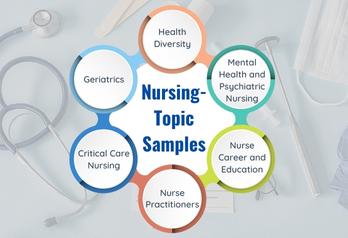Topic - 1: Assessment of Nurse–Midwives' Knowledge, attitude and Practices toward Mothers in the Labor room.
Over 1.2 billion women get pregnant each year. Most conceptions result in the delivery of a healthy baby to a healthy mother. Others see labour as a moment of excruciating pain, overwhelming worry, unending sorrow, and sometimes even death. Due to the obvious difficulties associated with giving birth, women often need assistance during the labour and delivery process (Hidaka & Callister, 2012). During the process of labour and delivery, the nurse-midwives should give care that is both attentive and sufficient, taking into account the individual needs of the patient and the patient's family. In order to assess the patient's and their families priorities when the patient is through such a physically and emotionally taxing phase, medical professionals need to analyse speedup and use their own personal attributes. The goal of routine obstetric care is to facilitate the development of a healthy mother and child with the fewest number of interventions possible while ensuring the patient's well-being (Gülmezoglu et al., 2016). Human labour is unexpectedly dangerous. Evolution should benefit moms who give birth without complications, but for those without access to appropriate medical care, the lifetime chance of dying during labour maybe 10% or more (Moucheraud et al., 2015). The researcher attempts to emphasise the function of the Nurse-Midwife in the delivery room in terms of employing reasonable and healthy practices that are compatible with solid knowledge across the phases of labour (Bohren et al., 2017).

Topic -2: A study on the need of Breast-Feeding Support to the First Time Mothers
Breast milk is a healthy, balanced diet that allows the infant to adjust to life, defends the newborns against infectious illnesses because of its particular composition, and supports the child's physical and cognitive demands (Gokce, 2016). The World Health Organization (WHO) advises that during the first 180 days of a newborn's life, the infant must consume nothing except breast milk (Organization, 2015). Individual or group instruction should be offered to new mothers and their partners in the hospital setting or at the mothers' homes to improve the successful breastfeeding rate (DURMAZOĞLU et al., 2020). As facilitators, caretakers, and counselors, nursing staff may use their responsibilities in the breastfeeding process to assist mothers in establishing healthy breastfeeding behaviours. According to research, first-time moms begin nursing later in the postpartum period and have lower rates of exclusive breastfeeding. Reasons for this include poor postpartum nurse assistance and breastfeeding issues such as nipple soreness, infant unable to latch on correctly, and low milk production (Hauck et al., 2011). First-time moms may be encouraged and assured with the help of nurses, and the objective of boosting exclusive rates can be met (Frei & Mander, 2011). The educational, technical, and social support provided by nurses has the ability to reduce the number of breastfeeding challenges and the amount of time spent in the hospital supplementing. In a busy hospital, the successful implementation of early maternal-infant skin-to-skin contact might potentially enhance the delivery of critical assistance.
References
- Bohren, M.A., Hofmeyr, G.J., Sakala, C., Fukuzawa, R.K. & Cuthbert, A. (2017). Continuous support for women during childbirth. Cochrane Database of Systematic Reviews, 2017 (8). DOI: 10.1002/14651858.CD003766.pub6.
- Gülmezoglu, A.M., Lawrie, T.A., Hezelgrave, N., Oladapo, O.T., Souza, J.P., Gielen, M., Lawn, J.E., Bahl, R., Althabe, F., Colaci, D. & Hofmeyr, G.J. (2016). Interventions to Reduce Maternal and Newborn Morbidity and Mortality. In: Disease Control Priorities, Third Edition (Volume 2): Reproductive, Maternal, Newborn, and Child Health. The World Bank, pp. 2. DOI: 10.1596/978-1-4648-0348-2_ch7.
- Hidaka, R. & Callister, L.C. (2012). Giving Birth With Epidural Analgesia: The Experience of First-Time Mothers. The Journal of Perinatal Education, 21 (1). pp. 24–35. DOI: 10.1891/1058-1243.21.1.24.
- Moucheraud, C., Worku, A., Molla, M., Finlay, J.E., Leaning, J. & Yamin, A.E. (2015). Consequences of maternal mortality on infant and child survival: a 25-year longitudinal analysis in Butajira Ethiopia (1987-2011). Reproductive Health, 12 (S1). pp. S4. DOI: 10.1186/1742-4755-12-S1-S4.
- DURMAZOĞLU, G., ÇEÇE, Ö., YAŞAROĞLU TOKSOY, S., OKUMUŞ, H. & ALUŞ TOKAT, M. (2020). Gebe okulu eğitimcileri ve emzirme hemşirelerine verilen Watson’ın İnsan Bakım Kuramına temellendirilmiş emzirme eğitiminin etkinliğinin değerlendirilmesi. Pamukkale Medical Journal, DOI: 10.31362/patd.758760.
- Frei, I.A. & Mander, R. (2011). The relationship between first-time mothers and care providers in the early postnatal phase: an ethnographic study in a Swiss postnatal unit. Midwifery, 27 (5). pp. 716–722.
- Gokce, I. (2016). Current approaches to enteral feeding in preterm infants /Preterm bebegin enteral beslenmesine guncel yaklasim. Journal of Turgut Ozal Medical Center, 23 (2). pp. 259. DOI: 10.5455/jtomc.2015.3296.
- Hauck, Y.L., Fenwick, J., Dhaliwal, S.S., Butt, J. & Schmied, V. (2011). The association between women’s perceptions of professional support and problems experienced on breastfeeding cessation: a Western Australian study. Journal of Human Lactation, 27 (1). pp. 49–57.
- Organization, W.H. (2015). WHO European Region has lowest global breastfeeding rates. Retrieved December, 14. pp. 2019.

